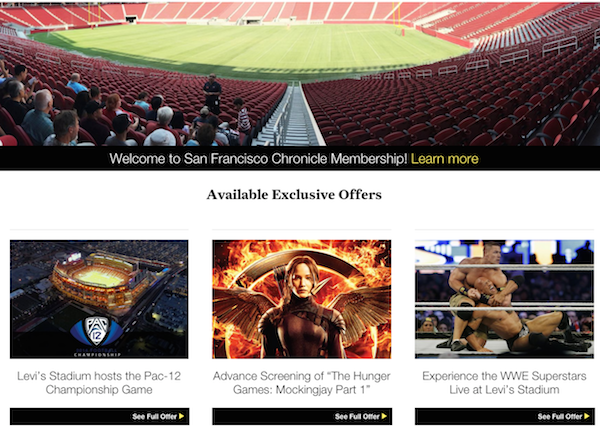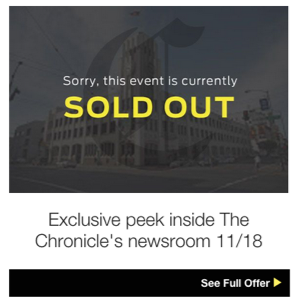
The San Francisco Chronicle wants you back — if you’re a subscriber, that is.
The Chronicle, a Hearst paper, launched a membership program a few months ago aimed at retaining subscribers and reducing churn. The program is free to both digital and print subscribers. All interested parties have to do is go to the Chronicle’s subscriber website — not to be confused with the non-paywalled but Chronicle-owned and operated SFGate.com — click the Membership tab and start signing up for perks.

Lots of newspapers have experimented with paid premium content and membership as a revenue strategy, but the Chronicle’s program is free with any subscription package. Though some events on offer might involve a small fee, the program’s end goal isn’t to make money, but to repair the relationship between the newspaper and its audience.
Publisher Jeff Johnson says that, over time, newspaper subscribers have increasingly been asked to carry more of the financial burden of circulation, paying more for an increasingly thin product.
“Historically, most of our connection with our readers has been the bill we send them,” he says. “We’re trying to create a face-to-face experience.”
 For Chronicle subscribers, that means around five events a week plus other perks. Members have the opportunity to do wine tastings with the Chronicle food critic, go to museums with the Chronicle art critic, tour downtown with a Chronicle urban design critic, join a book club with the Chronicle’s book critic, attend public forums with the editorial page writers, and more. Newsroom tours, with the opportunity to sit in on editorial meetings, are especially popular.
For Chronicle subscribers, that means around five events a week plus other perks. Members have the opportunity to do wine tastings with the Chronicle food critic, go to museums with the Chronicle art critic, tour downtown with a Chronicle urban design critic, join a book club with the Chronicle’s book critic, attend public forums with the editorial page writers, and more. Newsroom tours, with the opportunity to sit in on editorial meetings, are especially popular.
 “We even included an event where we brought our subscribers to the production facility,” says vice president of circulation Michael Cohen. “You wouldn’t think anyone would want to go to the distribution center.”
“We even included an event where we brought our subscribers to the production facility,” says vice president of circulation Michael Cohen. “You wouldn’t think anyone would want to go to the distribution center.”
While these journalist-hosted events are novel, the Chronicle’s membership website suggests much of the programming on offer is more typical loyalty rewards fare — tickets to sports games, advance movie screenings, access to conventions, and musical performances. Newspaper analyst and Lab contributor Ken Doctor says these tactics have been used in the past by newspaper publishers to build relationships with readers.
“They say, ‘You’re special!’ But what they are doing is, in part, collecting a bunch of things they did before,” Doctor says. He believes a more targeted program would be more effective. For example, the Chicago Tribune has an events arm called Trib Nation in which digitalPLUS subscribers get discounted tickets, which is quite similar to the San Francisco Chronicle’s program. But the Tribune also offers Printer’s Row, a premium books vertical that offers literary events to a niche audience inside its general readership; this is the kind of segmentation that the Chronicle’s program lacks, Doctor says.
But while the program may be a bit unfocused and unoriginal, early feedback suggests it’s working — 80 percent of those surveyed said membership made them more likely to renew, according to Chronicle vice president of marketing Erin Skidmore.Surprisingly, the membership program is also popular with newsroom employees. “They come to me and say, I want to do something, what can I do?” Skidmore says. Though Chronicle journalists, like journalists everywhere, are busy both with reporting and writing as well as the increasing pressure to engage with readers digitally, Skidmore says staff have been widely appreciative of the value of meeting readers in person.
“If you do enough events, and you have enough touch points and enough members participate, what’s the value of that?” asks Johnson. “The value should be they have a stronger affinity to the Chronicle and are going to stay with you longer than what your historical patterns have been.”
The Chronicle’s membership program is not just about getting subscribers to renew — it’s about engendering brand loyalty in the audience in hopes they’ll continue to renew for years down the line. Considering that three quarters of newspaper subscribers are 45 or older, it would make sense for the Chronicle to use the program to target younger readers. But Johnson says, for now, they’re not tracking demographic information or trying to grow the subscriber base.
“We didn’t come up with it to be an acquisition tool, not that it doesn’t have an impact on acquisition. We view it, at least at this point, as a retention tool,” he says.
The Chronicle is not the first Hearst newspaper to experiment with membership. The Houston Chronicle, which also has a two-site strategy, launched its Star Access program about two years ago. The rules are slightly more complicated for Star Access; subscribers who want Star Access need to pay at least $2.50 a week. Originally, the program was conceived to move customers up the payment ladder, but vice president of consumer sales Michael Gorman says the paper had to scale back from that goal.
“We saw modest success, but we also saw we were limiting our ability to attract digital users, because a percentage of our subscriber base fell below that $2.50 subscription,” he says. “We were not doing as well as we would have liked moving them up the scale.”
So in March the paper switched to a two-tiered system in which all subscribers are also members, but premium members who pay more than $2.50 are “Insiders.” Gorman is still working out what some of the premium benefits for Insiders will be; for now they get “white glove customer service,” and access to ticket giveaways and contests that regular members don’t get. For example, Insiders received discounted tickets to an event called Houston Chronicle Culinary Stars, celebrating food writer Allison Cook’s 100 best restaurants in Houston.
But while Gorman says offering these interactive experiences might help reduce churn, it’s not what he believes drives readers to pay for the program. “We see people under that $2.50 mark who just get the Sunday paper, they have a high level of interest in coupons and ads,” he says. “To make available to them retailer benefits so they can see real household savings based on being an Insider — that’s where this will be a real home run for us.”
Another paper, The Day in New London, Connecticut, has also tried a membership program that’s free with a subscription. Called Passport, members get classic perks like entry into contests, event access, discount tickets, and even the occasional cruise giveaway. Michael Moses, The Day’s director of marketing and digital strategy, says event tickets and gift cards are easily the most popular membership benefits among readers. “There’s nothing innovative about it,” he says. “What folks want is still the same thing they’ve always wanted.”
But there is something innovative about what The Day gets from the program, and it goes beyond consumer loyalty. Since 2011, the paper has been growing a database of user info that now contains over 220,000 households across southeastern Connecticut. Moses says they use “72 different behavior profile categories” to break down their audience, which can be segmented even further into groups of current members, former members, and even recently lapsed members.“Every bit of information that’s entered by a member — what [events] they participate in, what stories they read, what their shopping behaviors are — all that goes into our database,” Moses says.
The Day has been able to use that data to target acquisition campaigns with great accuracy — for example, digital only campaigns aimed at 25 to 35 year olds who are registered users and therefore more likely to bump up to subscribers. This strategy has given the paper a retention rate of around 70 percent, according to Moses, with new four-day subscriptions increasing by 12 percent year over year, Sunday subscriptions by 10 percent, and digital-only subscriptions growing by 20 percent.
This is the kind of small-data segmenting that Ken Doctor says the San Francisco Chronicle should be doing with their new program, but isn’t.
“Okay, what we want is retention. Then what we should be asking is, what’s the profile of the person who is going to cancel?” he says. “We’ve had X number of cancellations over the last year. Tell me, analytics department — if you have one — what’s the profile of this person? And what is likely to stop them from canceling? What are their stated and what are their real reasons for canceling? Then, you would design a program based on the likely answers to that question.”
But the Chronicle has gone about their membership program in the opposite direction, creating experiences for a general readership and hoping they like it enough to keep subscribing. It’s a very different approach from the Houston paper, which seems to have settled on a retro approach of offering savings in exchange for incrementally more expensive subscriptions. It remains to be seen which value exchange will be more profitable. And even if the San Francisco Chronicle sees more renewals as a result of the membership program, that’s only a small chip in the much larger problems of an aging subscriber base and waning interest in newspapers among younger generations. (The paper has taken some steps towards attracting a younger audience, for example the Love Local festival which was held in November.)
There’s something genuine about the strategy of wanting to connect with readers; making users feel valued and listened to could be an effective way to retain their affinity. But, after years of declining returns for newspaper subscribers, the attempt to repair that relationship with wine tastings and ticket giveaways might be too little too late.
“They like the word membership, they know it implies a deeper relationship,” says Doctor. “But they have not figured out what that relationship is.”